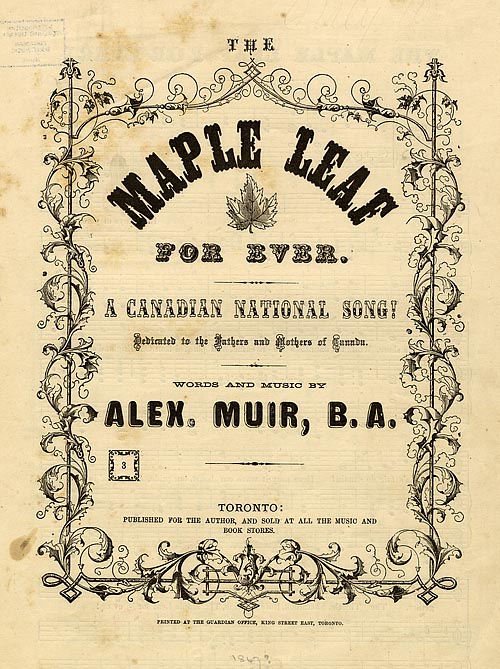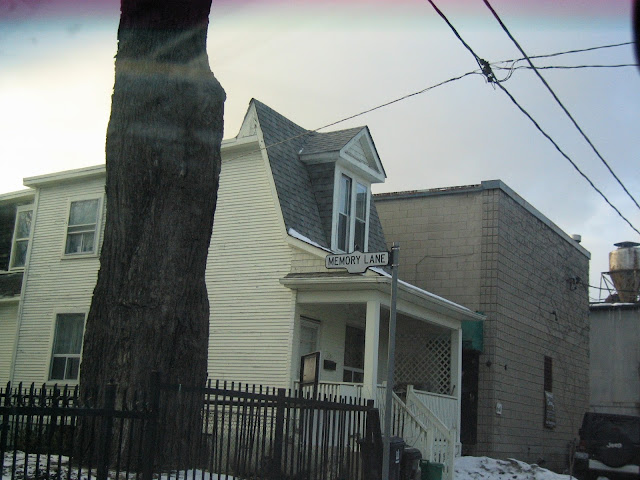In honour of Canada's 150th birthday today, July 1.

Alexander Muir was principal of the public school in Leslieville, an area of Toronto named for his friend, horticulturalist and postmaster George Leslie.
For many years there was a mural painted by some students from nearby Ralph Thornton Centre. Twelve years later the crumbling wall needed fixing.The peeling paint was tough to match and people kept changing Muir to look like the Joker or Adolf Hitler.

A new mural was unveiled in 2016 depicting neighbourhood pioneer Alexander Muir, sitting under a famous maple tree done by artist Elicser Elliott.
Muir was said to have been inspired to write this song by a large maple tree which stood on his street in front of Maple Cottage, a house at Memory Lane and Laing Street in Toronto.
Photos taken 2009
The tree which inspired Muir's song was felled during a windstorm on the night of 19/20 July 2013.Residents have expressed their hope that the city will be able to start a new tree from one of the branches.
During the early 1870s, Alexander Muir was an elementary school teacher in Newmarket, north of Toronto. When the cornerstone of the Christian Church in Newmarket was being laid on June 25, 1874 by the Governor General, Lord Dufferin, Muir brought his school choir to the event to sing his new composition, "The Maple Leaf Forever", its first public performance.
It has been asserted that Muir's words, however, while certainly pro-British, were not anti-French, and he revised the lyrics of the first verse from "Here may it wave, our boast, our pride, and join in love together / The Thistle, Shamrock, Rose entwine" to "/ The Lily, Thistle, Shamrock, Rose, the Maple Leaf forever" – the thistle represented Scotland; the shamrock, Ireland; and the rose, England – adding "Lily", a French symbol, to the list. According to other accounts, this was actually the original wording. Muir was attempting to express that under the Union Flag, the British and French were united as Canadians.
"The Maple Leaf Forever" is also the authorized regimental march of The Royal Westminster Regiment. Additionally, it is the Regimental Slow March of the Fort Henry Guard.
The song makes reference to James Wolfe capturing Quebec in 1759 during the Seven Years' War and the Battle of Queenston Heights and Battle of Lundy's Lane during the War of 1812.
A slightly revised version of the lyrics, with the fourth and fifth verses omitted, was sung by Anne Murray before the final game played by the Toronto Maple Leafs at Maple Leaf Gardens.
It has been asserted that Muir's words, however, while certainly pro-British, were not anti-French, and he revised the lyrics of the first verse from "Here may it wave, our boast, our pride, and join in love together / The Thistle, Shamrock, Rose entwine" to "/ The Lily, Thistle, Shamrock, Rose, the Maple Leaf forever" – the thistle represented Scotland; the shamrock, Ireland; and the rose, England – adding "Lily", a French symbol, to the list. According to other accounts, this was actually the original wording. Muir was attempting to express that under the Union Flag, the British and French were united as Canadians.
"The Maple Leaf Forever" is also the authorized regimental march of The Royal Westminster Regiment. Additionally, it is the Regimental Slow March of the Fort Henry Guard.
The song makes reference to James Wolfe capturing Quebec in 1759 during the Seven Years' War and the Battle of Queenston Heights and Battle of Lundy's Lane during the War of 1812.
A slightly revised version of the lyrics, with the fourth and fifth verses omitted, was sung by Anne Murray before the final game played by the Toronto Maple Leafs at Maple Leaf Gardens.







...nice to see Elicser's work, Happy Birthday Canada.
ReplyDeleteFine looking murals.
ReplyDeleteI do like the song. I hope the transplanted branch can resurrect the tree- something similar was done up at Rideau Hall with a tree originally planted by Harry Truman back in the late 40s.
ReplyDelete